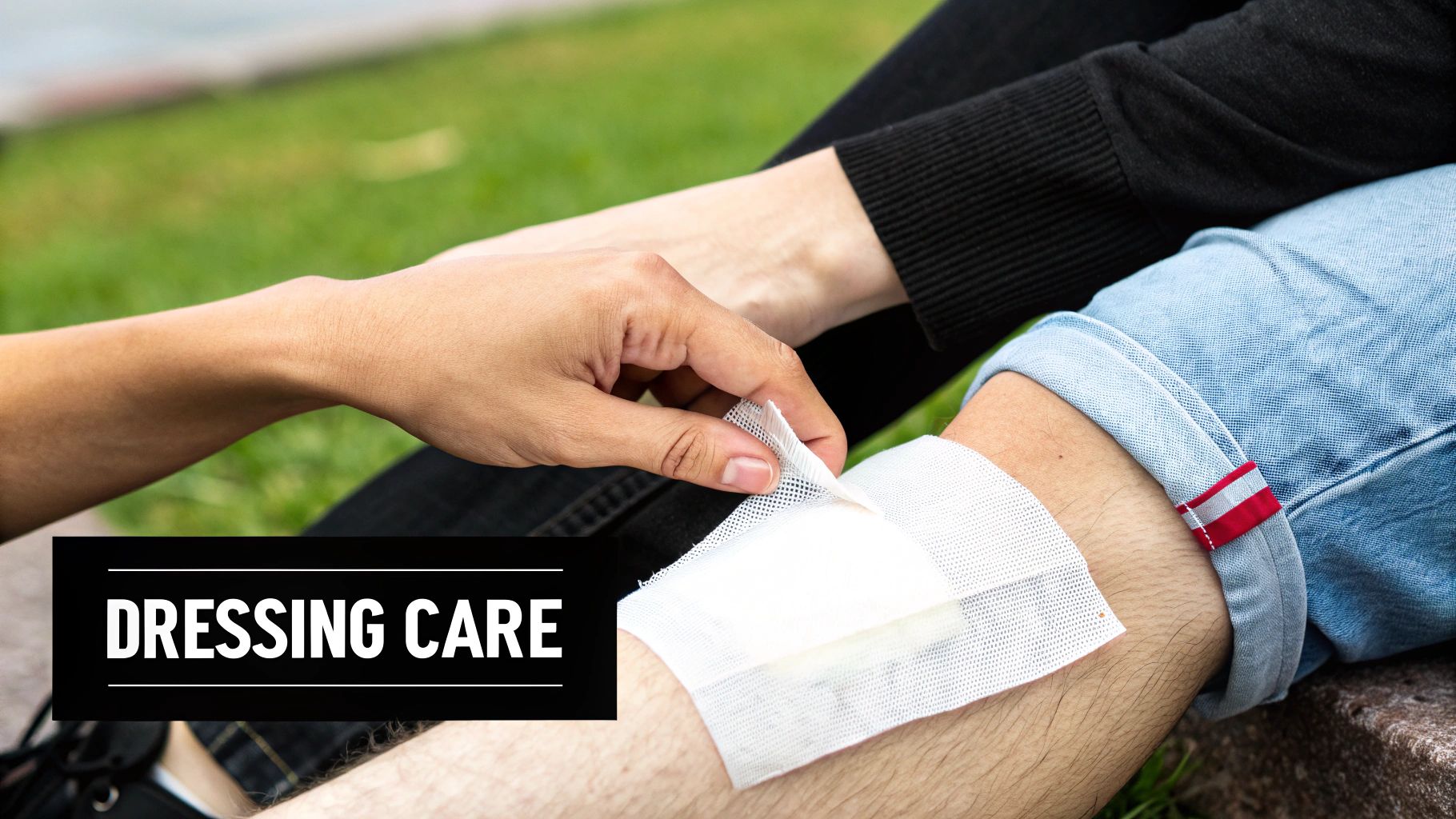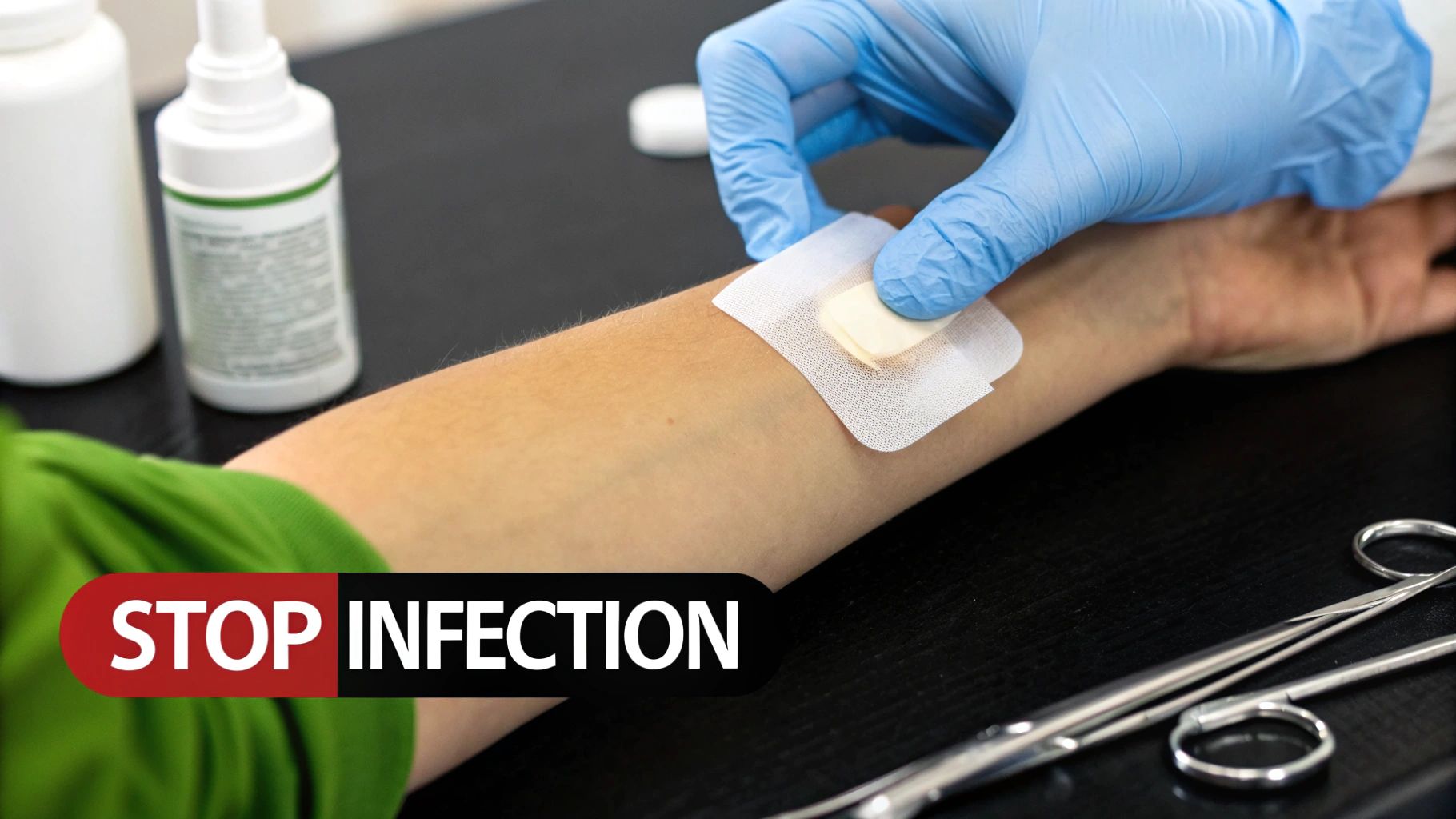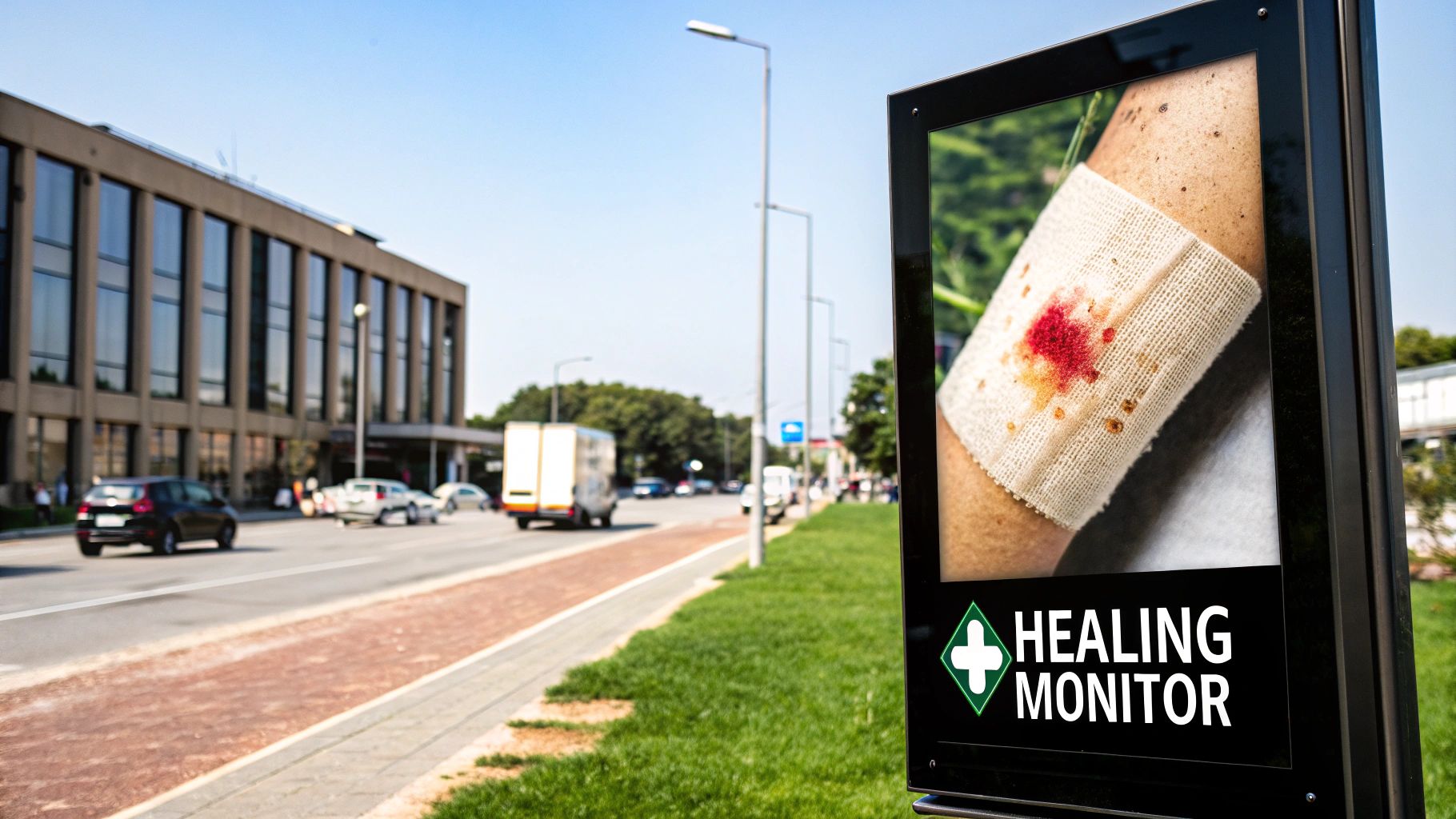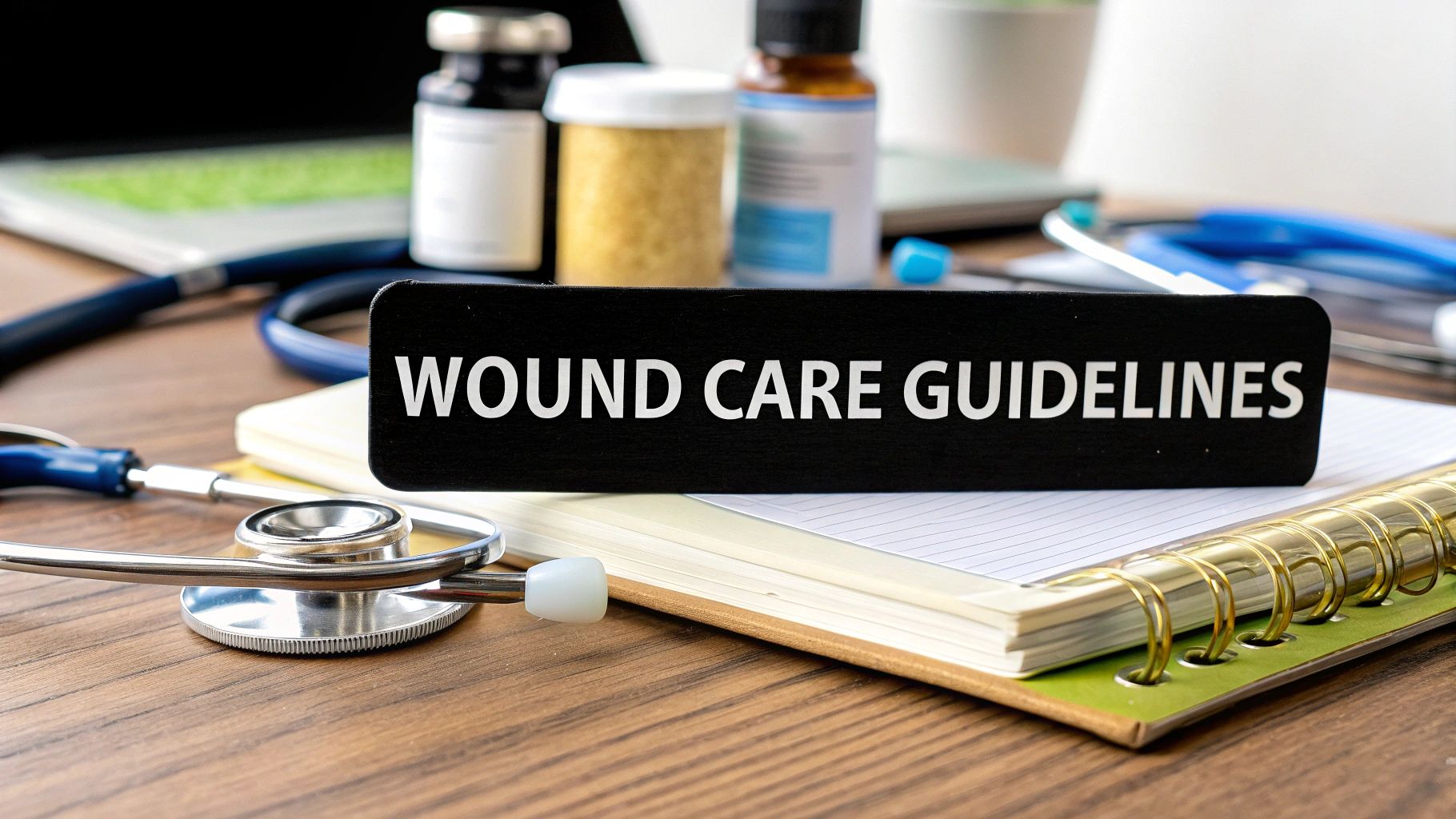Wound care has come a long way. From ancient civilizations using readily available resources like mud, herbs, and honey to the advanced techniques we have today, the field has constantly evolved. These early practices represent wound care’s fundamental beginnings as a survival skill.
Early humans recognized the antibacterial properties of these natural substances. This laid the foundation for today’s more complex wound care guidelines. Learn more about this fascinating history at Skilled Wound Care.
The Impact of Germ Theory
The 19th century brought a monumental shift in understanding with the introduction of germ theory. This new awareness of microorganisms and their connection to disease transformed wound treatment.
Joseph Lister pioneered the use of carbolic acid as an antiseptic, dramatically reducing surgical mortality rates. This emphasized the vital role of infection prevention in wound healing. Later, the development of sterilization techniques further cemented the move toward aseptic practices.
Modern Advancements in Wound Care
The 20th and 21st centuries witnessed a surge in new wound care technologies and methods. Synthetic polymer dressings offered clear benefits over traditional materials. The rediscovery of moist wound healing in the 1960s further revolutionized treatment.
Moist wound healing accelerates the healing process by creating an optimal moist environment. This supports the body’s natural healing mechanisms. Today’s guidelines stress comprehensive patient assessments, personalized treatment plans, and coordinated care. Effective care coordination strategies, like those discussed by Caring Hands Senior Services, play a crucial role.
Modern wound care considers the patient’s overall health and well-being, not just the wound itself. The journey from basic wound care to advanced treatments showcases remarkable progress in healthcare, continually shaped by research and innovation.
Foundational Principles That Transform Wound Healing

Modern wound care guidelines emphasize a holistic approach, building on years of advancements. This approach goes beyond simply dressing a wound. It focuses on fostering the best possible healing environment. Understanding these core principles is essential for effective wound management.
The TIME Framework: A Cornerstone of Wound Care
The TIME framework is a widely recognized approach providing structure to wound assessment and treatment. TIME stands for Tissue, Infection, Moisture, and Edge. Each element is critical to the healing process.
- Tissue Management: This involves evaluating the wound bed for necrotic tissue, slough, or foreign material that might hinder healing. Effective debridement techniques are essential to remove these obstacles and encourage healthy tissue growth.
- Infection Control: Infection can substantially slow or even stop wound healing. Recognizing infection signs like increased exudate, odor, or pain is crucial. Implementing appropriate measures such as antimicrobial dressings or systemic antibiotics is vital.
- Moisture Balance: Maintaining proper moisture in the wound bed is essential. Excessive moisture can damage surrounding skin, while insufficient moisture can hinder cell migration and slow closure. The correct balance promotes optimal healing.
- Edge Advancement: Looking at the wound edges for epithelialization (new skin growth) signals healing progress. Addressing factors that inhibit edge advancement, such as undermining or rolled edges, encourages closure.
Comprehensive Wound Assessment: Beyond the Surface
Effective wound care requires a thorough assessment that considers the entire patient, not just the wound. This involves evaluating their medical history, nutritional status, and any underlying conditions impacting healing.
For instance, diabetes or vascular disease can significantly impair healing. Assessing the periwound skin for maceration, erythema, or edema also provides vital information for treatment planning.
This comprehensive approach allows for personalized treatment plans.
The following table outlines the essential elements of comprehensive wound care and their clinical importance.
Core Components of Wound Care Guidelines
| Component | Purpose | Clinical Importance | Implementation Guidelines |
|---|---|---|---|
| Tissue Management | Remove non-viable tissue and foreign material | Creates a clean wound bed for healing | Debridement (sharp, enzymatic, autolytic), wound cleansing |
| Infection Control | Prevent and treat wound infections | Minimizes complications and promotes timely healing | Antimicrobial dressings, systemic antibiotics, regular monitoring |
| Moisture Balance | Maintain an optimal wound environment | Supports cell migration and prevents desiccation | Appropriate dressings based on wound characteristics |
| Edge Advancement | Promote closure and epithelialization | Indicates healing progress and reduces scar formation | Addressing undermining, rolled edges, and promoting granulation tissue |
This table highlights the interconnectedness of the TIME framework and its role in comprehensive wound care. Each component contributes to creating an environment conducive to healing.
Statistical insights highlight that infection control and moisture balance are key to optimal healing. Chronic wounds affect 1-2% of the global population, emphasizing the need for standardized guidelines. Find more detailed statistics at WoundSource. Nurses looking to specialize might find Online Nursing Certifications helpful for advancing their wound care skills.
By understanding these foundational principles and using them in practice, healthcare professionals can provide better and more efficient wound care. This leads to improved patient outcomes and a reduced burden of chronic wounds. Applying these guidelines can significantly improve healing rates and minimize complications. These principles provide a solid framework for developing and implementing effective wound care strategies.
Mastering Essential Cleaning and Debridement Techniques

Proper cleaning and debridement are fundamental to effective wound care. These techniques are essential for preparing the wound bed for healing and preventing infections. This section explores these important practices.
Wound Cleaning: The First Line of Defense
Wound cleaning focuses on removing debris, bacteria, and foreign material without harming the surrounding healthy tissue. Choosing the right cleaning solution and technique depends on the nature of the wound.
Normal saline is often the preferred solution for acute wounds. For chronic wounds with significant exudate or necrotic tissue, a more specialized cleanser might be required. Irrigation pressure is another key factor.
High-pressure irrigation effectively removes debris but can also damage fragile tissue. Low-pressure irrigation is gentler but may not be as effective at removing stubborn debris. Selecting the correct pressure based on individual wound characteristics is vital for creating a clean healing environment.
Debridement: Removing Barriers to Healing
Debridement, the removal of non-viable tissue, is often necessary to encourage healing. This critical step prepares the wound bed and helps prevent complications. There are five main types of debridement:
- Autolytic Debridement: The body’s natural enzymes break down the necrotic tissue. This gentle method is often used for wounds with minimal exudate.
- Enzymatic Debridement: Applying enzymes to break down necrotic tissue is often preferred for wounds with moderate to heavy exudate.
- Mechanical Debridement: This involves using physical methods, such as wet-to-dry dressings, to remove necrotic tissue. While effective, it can also be painful.
- Surgical Debridement: A surgical procedure, typically performed by a physician, to remove necrotic tissue. This is often required for deep or extensive wounds.
- Biosurgical Debridement: Using sterile, medicinal maggots to selectively remove necrotic tissue. This is becoming a more popular, less invasive alternative to surgical debridement.
The best debridement method depends on factors like the wound type, the patient’s overall health, and available resources. The goal is to effectively remove necrotic tissue while minimizing trauma to healthy tissue. For instance, autolytic debridement might be appropriate for a small, superficial wound, while surgical debridement could be necessary for a large, deep wound with extensive necrosis.
Thorough documentation of these procedures is vital for continuity of care. It allows other healthcare professionals to understand the treatment plan and track progress. This documentation also supports medical necessity for billing and reimbursement. Following best practices for cleaning and debridement, along with meticulous documentation, ensures patients receive the most effective care for their individual needs.
Selecting Dressings That Actually Accelerate Healing

Choosing the right wound dressing is a crucial part of wound care. With so many options available, it can be difficult to know which one is best. This section provides a practical guide to understanding wound dressings and making informed choices.
Moisture Management: The Key to Healing
The moisture level of a wound bed plays a vital role in the healing process. Too much moisture can damage the surrounding skin, while too little can slow down cell growth. Maintaining the right balance is essential for optimal healing.
Moisture-donating dressings, such as hydrogels, are perfect for dry wounds. These dressings add moisture to the wound, creating an environment that promotes healing. A dry, necrotic wound, for instance, would benefit from a hydrogel.
On the other hand, highly absorbent dressings, like alginates and foams, are best for wounds with a lot of drainage. These dressings help manage excess fluid, preventing further complications. A heavily draining wound, like a venous ulcer, needs this type of absorbent dressing.
Navigating the Dressing Landscape
Understanding the different types of wound dressings simplifies the selection process. This knowledge allows healthcare professionals to choose the best dressing for each unique wound. Here’s a quick overview of some common types:
- Films: Thin and transparent, these dressings protect superficial wounds and allow for easy monitoring. However, they’re not suitable for wounds with heavy drainage.
- Foams: Available in different thicknesses and absorbencies, foams provide cushioning and manage moderate to heavy drainage.
- Hydrocolloids: These dressings form a gel-like covering, creating a moist healing environment. They are not ideal for infected wounds.
- Hydrogels: These moisture-rich dressings hydrate and soothe dry wounds, facilitating faster healing. They offer minimal absorption.
- Alginates: Derived from seaweed, alginates are highly absorbent and perfect for heavily draining wounds. They can also help stop bleeding.
- Antimicrobial Dressings: These dressings contain antimicrobial agents like silver or iodine to prevent or manage infection. They are particularly helpful for patients at higher risk of infection.
The following table offers a helpful guide for selecting the appropriate dressing:
To help you choose the right dressing, we’ve put together a quick guide:
Wound Dressing Selection Guide
| Dressing Type | Best For | Advantages | Disadvantages | Change Frequency |
|---|---|---|---|---|
| Film | Superficial wounds, minimal drainage | Protects, allows visualization | Not absorbent | 1-7 days |
| Foam | Moderate to heavy exudate, cushioning | Absorbent, protective | May require secondary dressing | 1-3 days |
| Hydrocolloid | Partial- to full-thickness wounds, autolytic debridement | Moist environment, promotes healing | Not for infected wounds | 3-7 days |
| Hydrogel | Dry wounds, burns | Hydrates, soothes | Minimal absorption | 1-3 days |
| Alginate | Heavy exudate, bleeding wounds | Highly absorbent, hemostatic | Can dry out wound if not enough exudate | 1-3 days |
| Antimicrobial | Infected or high-risk wounds | Prevents/manages infection | May irritate sensitive skin | Per physician order |
This table summarizes the key features and uses of common wound dressings, making it easier to choose the most appropriate option.
Addressing Challenging Scenarios
Some wounds present unique challenges. Sensitive skin, for example, may require dressings with gentle adhesives. Fungating wounds often need absorbent dressings to manage drainage and odor. Wounds in difficult locations may require dressings that can conform to the body’s contours.
Atraumatic dressing removal is also an important consideration. Ripping off a dressing can damage new tissue and cause pain. Using dressings with silicone adhesives or applying saline to loosen the dressing can make removal less painful and traumatic.
At Rapid Wound Care, we offer comprehensive at-home wound care services. Our certified professionals assess each patient’s individual needs and create personalized treatment plans using the most appropriate dressings and techniques. We effectively manage various wound types, promoting optimal healing and improving patient well-being. By following evidence-based guidelines, we’re committed to helping patients achieve the best possible results.
Preventing Infections That Derail Healing Progress
Infection is a serious risk to wound healing, no matter where the care is given. This makes infection prevention a top priority in wound care guidelines. This section discusses how to prevent, identify, and effectively manage wound infections.
Differentiating Inflammation from Infection
Knowing the difference between normal inflammation and a true infection is crucial for proper wound care. Inflammation is a natural part of healing, marked by redness, swelling, and warmth around the wound.
Infection, on the other hand, signals harmful bacteria are overwhelming the body’s defenses. This can lead to increased pain, purulent drainage (pus), a bad smell, and sometimes fever or chills. Recognizing these differences is key to applying the right treatment.
Biofilm formation, where bacteria clump together on the wound surface, is a common cause of stubborn infections. Biofilms protect bacteria from the immune system and antibiotics, making these infections tough to treat. This underscores the importance of early intervention.
Diagnosing and Managing Infection
Proper wound culturing helps identify the specific bacteria causing infection. This guides treatment choices and helps stop the spread of antibiotic-resistant organisms.
Antimicrobial dressings are often the first line of defense. These dressings apply medication directly to the wound, reducing side effects elsewhere in the body. Choosing the right antimicrobial is essential.
Systemic antibiotics are usually reserved for more severe or widespread infections. Careful use is crucial to prevent the development of further antibiotic resistance. Antimicrobial stewardship programs promote responsible antibiotic prescription and use.
Infection Control Best Practices
Infection control protects both patients and healthcare professionals. Hand hygiene is paramount. Washing hands thoroughly before and after every patient interaction lowers the risk of spreading infection.
Proper disposal of contaminated materials, like dressings and instruments, is also critical. Following established procedures helps control infection spread and protects the environment. Consistent use of personal protective equipment (PPE) is vital when handling infected wounds.
These strategies show how important infection prevention and control are in wound care guidelines. At Rapid Wound Care, we prioritize infection prevention and control. We offer complete at-home care, including wound assessment, cleaning, debridement, dressing application, and infection management. By sticking to best practices and focusing on early intervention, we strive to minimize complications and promote optimal healing for everyone.
Breaking Through Plateaus in Chronic Wound Management
Chronic wounds pose a significant healthcare challenge. These wounds, including diabetic foot ulcers, pressure injuries, and vascular ulcers, often resist standard treatments, necessitating specialized care to jumpstart healing. This section delves into the complexities of chronic wound management and strategies to overcome healing plateaus.
Understanding the Challenges of Chronic Wounds
Chronic wounds differ from acute wounds in their underlying pathophysiology. Factors like poor blood flow, uncontrolled diabetes, and persistent inflammation contribute to slow healing. For instance, in diabetic foot ulcers, nerve damage and reduced circulation create an environment where minor injuries can become chronic.
Addressing these underlying issues is critical for successful chronic wound management. Simply changing dressings without addressing the root cause is often ineffective. This underscores the need for a comprehensive approach.
Evidence-Based Interventions for Chronic Wounds
When a chronic wound stalls, specialists employ various advanced techniques to encourage healing. These techniques, tailored to the specific wound etiology, may include:
- Offloading: Reducing pressure, especially vital for pressure injuries, allows tissue regeneration. Specialized footwear, cushions, and support surfaces can redistribute pressure.
- Compression Therapy: This helps manage swelling and improve blood flow, particularly beneficial for venous ulcers. Varying compression levels are used depending on severity and patient comfort.
- Negative Pressure Wound Therapy (NPWT): Also known as vacuum-assisted closure, NPWT uses negative pressure to remove excess fluid, promote new tissue growth, and reduce bacteria.
- Advanced Biologics: Skin substitutes, growth factors, and other biological therapies can stimulate cell growth and accelerate healing in complex wounds. These are usually reserved for unresponsive wounds.
Addressing Systemic Factors
Effective chronic wound management extends beyond local wound care. Systemic factors are critical for healing. For example, adequate nutrition provides the building blocks for tissue repair. Proper glycemic control in diabetic patients optimizes blood flow and immune function.
Ensuring adequate perfusion (blood supply) is essential. This might involve managing underlying vascular disease or using medications to enhance circulation. Addressing systemic factors creates a supportive healing environment.
Setting Realistic Expectations
Managing expectations is crucial. Chronic wounds often require prolonged treatment, and healing isn’t always linear. Setbacks can occur. Open communication between healthcare providers and patients sets achievable goals and prevents discouragement.
Educating patients about their condition, treatment options, and the importance of following the care plan empowers them in their healing process. At Rapid Wound Care, we specialize in treating chronic wounds, offering at-home services adapted to each patient’s needs. We provide comprehensive care, addressing both local and systemic factors affecting wound healing. Our certified team is dedicated to helping patients achieve optimal outcomes. We are committed to providing evidence-based care, education, and support throughout the healing journey.
Documentation Strategies That Improve Care Coordination
Wound care documentation is more than just fulfilling requirements. It’s a vital tool for making informed clinical decisions, ensuring seamless care transitions, and ultimately, improving patient outcomes. This section explores practical approaches for standardized wound assessment documentation that effectively captures essential information while remaining efficient in busy clinical settings.
Standardized Wound Assessment: Key Elements
Effective wound care programs often use standardized methods for assessing and documenting wounds. This consistent approach helps track significant changes in wound condition over time. Key elements include:
- Precise Measurements: Accurate wound measurements (length, width, depth) are crucial. Using a consistent technique, such as the clock method (visualizing the wound as a clock face), minimizes variations.
- Tissue Classification: Describing the wound bed tissue (e.g., granulation, slough, eschar) offers valuable insights into the healing process. Standardized systems, like the Bates-Jensen Wound Assessment Tool, can improve accuracy and inter-rater reliability.
- Periwound Assessment: Noting the condition of the skin surrounding the wound (e.g., maceration, erythema, edema) is essential for preventing complications and supporting healthy healing.
These standardized practices promote consistency and facilitate communication among the entire care team, ensuring that no important detail is missed.
The Power of Visual Records: Photography Protocols
Photographs offer a powerful visual record of wound progress. Evidence-based photography protocols maintain patient dignity while providing valuable data for clinical decision-making. Key considerations include:
- Informed Consent: Always obtain patient consent before taking any photographs.
- Maintaining Privacy: Ensure appropriate draping and positioning to protect patient privacy.
- Standardized Technique: Use a consistent background, lighting, and scale (e.g., a ruler) to allow for accurate comparisons over time.
Photographs offer objective evidence of healing progress or the development of complications. This visual record can be especially useful during interdisciplinary communication and consultations.
Streamlining Documentation: Templates and Tools
Using standardized templates can considerably improve the efficiency of wound care documentation. These templates provide a structure for recording key information, minimizing omissions and reducing documentation time. Examples include:
- Wound Assessment Forms: These forms prompt clinicians to document important wound characteristics, treatments, and observations.
- Debridement Documentation Templates: These templates simplify the process of recording the type, extent, and results of debridement procedures.
Templates and tools help standardize the documentation process, leading to consistent, high-quality records which are essential for tracking patient progress and justifying the medical necessity of interventions.
Interdisciplinary Communication: Sharing Crucial Information
Effective communication between all members of the care team is paramount for optimal wound care. Documentation strategies support this communication by ensuring that every team member can access the information they need. This collaborative approach is particularly important during transitions of care, such as when a patient moves from hospital care to home healthcare.
- Clear and Concise Language: Use clear and concise language in documentation, avoiding jargon or abbreviations that might be misunderstood.
- Timely Documentation: Document assessments and treatments promptly so that information is readily available to other team members.
- Structured Communication Channels: Establish clear communication channels for sharing wound care information, such as shared electronic health records or regular interdisciplinary meetings.
These strategies minimize errors and promote consistent care across different settings. Ultimately, this effective information sharing leads to improved patient outcomes.
For expert wound care management in the comfort of your home, contact Rapid Wound Care at https://rapidwoundcare.com. Our certified professionals develop personalized treatment plans using the most effective techniques, supported by detailed documentation to track your progress every step of the way. We are dedicated to helping you heal efficiently and regain your well-being.

